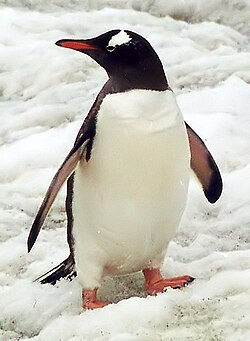This is an old revision of this page, as edited by 169.244.120.253 (talk) at 13:47, 18 December 2007 (→Etymology). The present address (URL) is a permanent link to this revision, which may differ significantly from the current revision.
Revision as of 13:47, 18 December 2007 by 169.244.120.253 (talk) (→Etymology)(diff) ← Previous revision | Latest revision (diff) | Newer revision → (diff) For other uses, see Penguin (disambiguation).
| Penguins Temporal range: Paleocene-Recent | |
|---|---|

| |
| Gentoo Penguin, Pygoscelis papua | |
| Scientific classification | |
| Kingdom: | Animalia |
| Phylum: | Chordata |
| Class: | Aves |
| Order: | Sphenisciformes Sharpe, 1891 |
| Family: | Spheniscidae Bonaparte, 1831 |
| Modern genera | |
| |

Penguins (order Sphenisciformes, family Spheniscidae) are a group of aquatic, flightless birds living almost exclusively in the Southern Hemisphere.
The number of penguin species is debated. Depending on which authority is followed, penguin biodiversity varies between 17 and 20 living species, all in the subfamily Spheniscinae. Some sources consider the White-flippered Penguin a separate Eudyptula species, while others treat it as a subspecies of the Little Penguin (e.g. Williams, 1995; Davis & Renner, 2003); the actual situation seems to be more complicated (Banks et al. 2002). Similarly, it is still unclear whether the Royal Penguin is merely a color morph of the Macaroni penguin. Also eligible to be a separate species is the Northern population of Rockhopper penguins (Davis & Renner, 2003). Although all penguin species are native to the southern hemisphere, they are not, contrary to popular belief, found only in cold climates, such as Antarctica. In fact, only a few species of penguin actually live so far south. At least ten species live in the temperate zone; one lives as far north as the Galápagos Islands: the Galápagos Penguin.
The largest living species is the Emperor Penguin (Aptenodytes forsteri): adults average about 1.1 m (3 ft 7 in) tall and weigh 35 kg (75 lb) or more. The smallest penguin species is the Little Blue Penguin (also known as the Fairy Penguin), which stands around 40 cm tall (16 in) and weighs 1 kg (2.2 lb). Among extant penguins larger penguins inhabit colder regions, while smaller penguins are generally found in temperate or even tropical climates (see also Bergmann's Rule). Some prehistoric species attained enormous sizes, becoming as tall or as heavy as an adult human (see below for more). These were not restricted to Antarctic regions; on the contrary, subantarctic regions harboured high diversity, and at least one giant penguin occurred in a region not quite 2000 km south of the Equator 35 mya, in a climate decidedy warmer than today.
Most penguins feed on krill, fish, squid, and other forms of sealife caught while swimming underwater. They spend half of their life on land and half in the oceans.
Penguins seem to have no special fear of humans and have approached groups of explorers without hesitation. This is probably on account of there being no land predators in Antarctica or the nearby offshore islands that prey on or attack penguins. Instead, penguins are at risk at sea from predators such as the leopard seal. Typically, penguins do not approach closer than about 3 meters (9 ft); they become nervous at about that distance. This is also the distance that Antarctic tourists are told to keep from penguins (tourists are not supposed to approach closer than 3 meters, but are not expected to withdraw if the penguins come closer).
Penguins Are now an official extinct species in the wild. The only ones left are the ones in the zoos. This is all on your shoulders you people that drive big SUVs, and need a new can of hairspray every other hour.
The late Save The Penguin Society
Systematics and evolution
Penguins and humans
Penguins in popular culture

Penguins are popular around the world, primarily for their unusually upright, waddling pace and (compared to other birds) lack of fear of humans. Their striking black and white plumage is often likened to a tuxedo suit. Perhaps in reaction to this cutesy stereotype, fictional penguins are occasionally presented as grouchy or even sinister. Penguins have also been the subject of many books and documentary films such as Happy Feet and Surf's Up, both CGI-Animated Animal Adventure Films, March of the Penguins, a documentary based on the migration process of Emperors, and a parody film entitled Farce of the Penguins. Mistakenly, some artists and writers have penguins based in the North Pole. This is incorrect as there are almost no wild penguins in the northern hemisphere, and those only barely (northernmost of the Galápagos). Penguins have also found their way into a number of cartoons and television dramas, perhaps the most notable of these is Pingu - created by Silvio Mazzola in 1986 and covering more than 100 short episodes.
Gallery of living species
-
 Emperor Penguins
Emperor Penguins
Aptenodytes forsteri -
 King Penguins
King Penguins
Aptenodytes patagonicus -
 Chinstrap Penguin
Chinstrap Penguin
Pygoscelis antarctica -
 Gentoo Penguin
Gentoo Penguin
Pygoscelis papua -
Royal Penguin
Eudyptes schlegeli -
 Southern Rockhopper Penguin
Southern Rockhopper Penguin
Eudyptes chrysocome -
 Fiordland Penguin
Fiordland Penguin
Eudyptes pachyrhynchus -
 Snares Penguin
Snares Penguin
Eudyptes robustus -
 Macaroni Penguin
Macaroni Penguin
Eudyptes chrysolophus -
 Yellow-eyed Penguin
Yellow-eyed Penguin
Megadyptes antipodes -
 Little Penguin or Fairy Penguin
Little Penguin or Fairy Penguin
Eudyptula minor -
African Penguin or Jackass Penguin Spheniscus demersus
African Penguin or Jackass Penguin
Spheniscus demersus -
 Galapagos Penguins
Galapagos Penguins
Spheniscus mendiculus -
 Humboldt Penguin
Humboldt Penguin
Spheniscus humboldti -
 Magellanic Penguin
Magellanic Penguin
Spheniscus magellanicus -
 Adélie penguins
Adélie penguins
Pygoscelis adeliae at iceberg in Ross Sea, Antarctica -
Emperor Penguins Aptenodytes forsteri (a parent with a chick)
Emperor Penguins
Aptenodytes forsteri (a parent with a chick) -
 Emperor Penguins
Emperor Penguins
Aptenodytes forsteri (a parent with a chick and lonely chick behind) -
 Emperor Penguins
Emperor Penguins
Aptenodytes forsteri - a chick -
 Macaroni penguin at South Georgia Island
Macaroni penguin at South Georgia Island
-
 Chinstrap Penguin feeding a chick in Antarctica
Chinstrap Penguin feeding a chick in Antarctica
-
 Adélie chicks in Antarctica
Adélie chicks in Antarctica
-
 Southern Elephant Seal and King Penguins
Southern Elephant Seal and King Penguins
References
- 2 new fossil penguin species found in Peru-
- Acosta Hospitaleche, Carolina (2004): Los pingüinos (Aves, Sphenisciformes) fósiles de Patagonia. Sistemática, biogeografía y evolución. Doctoral thesis, Department of Natural Sciences and Museum, Universidad Nacional de La Plata. La Plata, Argentina. PDF fulltext
- Baker, Allan J.; Pereira, Sergio Luiz; Haddrath, Oliver P. & Edge, Kerri-Anne (2006): Multiple gene evidence for expansion of extant penguins out of Antarctica due to global cooling. Proc. R. Soc. B 273: 11-17. doi:10.1098/rspb.2005.3260 PDF fulltext
- Banks, Jonathan C.; Mitchell, Anthony D.; Waas, Joseph R. & Paterson, Adrian M. (2002): An unexpected pattern of molecular divergence within the blue penguin (Eudyptula minor) complex. Notornis 49(1): 29–38. PDF fulltext
- Bertelli, Sara & Giannini, Norberto P. (2005): A phylogeny of extant penguins (Aves: Sphenisciformes) combining morphology and mitochondrial sequences. Cladistics 21(3): 209–239. doi:10.1111/j.1096-0031.2005.00065.x (HTML abstract)
- Clarke, Julia A.; Olivero, Eduardo B. & Puerta, Pablo (2003): Description of the earliest fossil penguin from South America and first Paleogene vertebrate locality of Tierra Del Fuego, Argentina. American Museum novitates 3423: 1-18. PDF fulltext
- Davis; Lloyd S. & Renner; M. (1995). Penguins . London: T & A D Poyser. ISBN 0-7136-6550-5
- Fain, Matthew G. & Houde, Peter (2004): Parallel radiations in the primary clades of birds. Evolution 58(11): 2558-2573. doi:10.1554/04-235 PDF fulltext
- Jadwiszczak, Piotr (2006): Eocene penguins of Seymour Island, Antarctica: taxonomy. Polish Polar Research 27(1), 3–62. PDF fulltext
- Jouventin, P; Aubin, T. & T Lengagne (1999) "Finding a parent in a king penguin colony: the acoustic system of individual recognition" Animal Behaviour 57: 1175–1183
- Ksepka, Daniel T., Bertelli, Sara & Giannini, Norberto P. (2006): The phylogeny of the living and fossil Sphenisciformes (penguins). Cladistics 22(5): 412–441. doi:10.1111/j.1096-0031.2006.00116.x (HTML abstract)
- Marples, B. J. (1962): Observations on the history of penguins. In: Leeper, G. W. (ed.), The evolution of living organisms. Melbourne, Melbourne University Press: 408-416.
- Mayr, G. (2005): Tertiary plotopterids (Aves, Plotopteridae) and a novel hypothesis on the phylogenetic relationships of penguins (Spheniscidae). Journal of Zoological Systematics and Evolutionary Research 43(1): 61-71. doi:10.1111/j.1439-0469.2004.00291.x PDF fulltext
- Sivak, J.; Howland, H. & McGill-Harelstad, P. (1987) "Vision of the Humboldt Penguin (Spheniscus humboldti) in Air and Water " Proceedings of the Royal Society of London. Series B, Biological Sciences. 229(1257): 467-472
- Slack, Kerryn E.; Jones, Craig M.; Ando, Tatsuro; Harrison G. L. "Abby"; Fordyce R. Ewan; Arnason, Ulfur & Penny, David (2006): Early Penguin Fossils, plus Mitochondrial Genomes, Calibrate Avian Evolution. Molecular Biology and Evolution 23(6): 1144-1155. doi:10.1093/molbev/msj124 PDF fulltext Supplementary Material
- Wever, E.; Herman, P.; Simmons, J. & Hertzler D (1969) "Hearing in the Blackfooted Penguin, Spheniscus demersus, as Represented by the Cochlear Potentials" PNAS 63(3): 676-680
- Williams; Tony D. (1995). The Penguins - Spheniscidae . Oxford: Oxford University Press. ISBN 0-19-854667-X
Footnotes
External links
- Penguin World
- penguinpage.net - Penguin research projects on the web
- Penguin information on 70South
- Information about penguins at pinguins.info
- PBS Nature: The World of Penguins
- Integrated Taxonomic Information System
- Seaworld Penguin Information
- Penguin Videos on the Internet Bird Collection
Template:Link FA Template:Link FA
Categories: